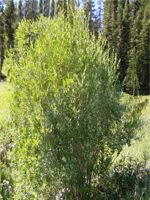Mon-Fri 9am - 5pm Mountain time
Bebbs Willow vs Black Locust
Salix bebbiana
Robinia pseudoacacia
This large shrub is native to all of Canada and most of the United States. Its leaves are green on the top and grey on the bottom, and it produces catkin based flowers and non-edible fruit which appears very similar to a group of pine needles.
Bebb's Willow is foraged for by many species including elk, hares, beavers and various birds. It is commonly used to prevent erosion and protect aquatic environments due to its preference for shady, moist environments.
Black Locust is an attractive tree. Its distinctive leaves are made of about a dozen bright green leaflets. It also notable for its fragrant white flowers, which smell of citrus.
Black Locust can grow in many situations, but prefers dry areas with lots of sun. It is robust and is an excellent choice for establishing shade in dry, open areas.
Important note: Much of the Black Locust is toxic to humans and livestock, including seeds, bark, and leaves.

